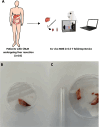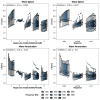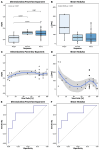Viscoelastic properties of colorectal liver metastases reflect tumour cell viability
- PMID: 39152426
- PMCID: PMC11328469
- DOI: 10.1186/s12967-024-05559-z
Viscoelastic properties of colorectal liver metastases reflect tumour cell viability
Abstract
Background: Colorectal cancer is the third most common tumour entity in the world and up to 50% of the patients develop liver metastases (CRLM) within five years. To improve and personalize therapeutic strategies, new diagnostic tools are urgently needed. For instance, biomechanical tumour properties measured by magnetic resonance elastography (MRE) could be implemented as such a diagnostic tool. We postulate that ex vivo MRE combined with histological and radiological evaluation of CRLM could provide biomechanics-based diagnostic markers for cell viability in tumours.
Methods: 34 CRLM specimens from patients who had undergone hepatic resection were studied using ex vivo MRE in a frequency range from 500 Hz to 5300 Hz with increments of 400 Hz. Single frequency evaluation of shear wave speed and wave penetration rate as proxies for stiffness and viscosity was performed, along with rheological model fitting based on the spring-pot model and powerlaw exponent α, ranging between 0 (complete solid behaviour) and 1 (complete fluid behaviour). For histological analysis, samples were stained with H&E and categorized according to the degree of regression. Quantitative histologic analysis was performed to analyse nucleus size, aspect ratio, and density. Radiological response was assessed according to RECIST-criteria.
Results: Five samples showed major response to chemotherapy, six samples partial response and 23 samples no response. For higher frequencies (> 2100 Hz), shear wave speed correlated significantly with the degree of regression (p ≤ 0.05) indicating stiffer properties with less viable tumour cells. Correspondingly, rheological analysis of α revealed more elastic-solid tissue properties at low cell viability and major response (α = 0.43 IQR 0.36, 0.47) than at higher cell viability and no response (α = 0.51 IQR 0.48, 0.55; p = 0.03). Quantitative histological analysis showed a decreased nuclear area and density as well as a higher nuclear aspect ratio in patients with major response to treatment compared to patients with no response (all p < 0.05).
Discussion: Our results suggest that MRE could be useful in the characterization of biomechanical property changes associated with cell viability in CRLM. In the future, MRE could be applied in clinical diagnosis to support individually tailored therapy plans for patients with CRLM.
Keywords: Colorectal liver metastases; Magnetic resonance elastography; Preoperative chemotherapy; Regression.
© 2024. The Author(s).
Conflict of interest statement
The authors declare that they have no competing interests.
Figures





References
-
- Siegel RL, Giaquinto AN, Jemal A, Cancer statistics, Cancer JC. 2024 Jan-Feb;74(1):12–49. Erratum in: CA Cancer J Clin. 2024 Mar-Apr;74(2):203. - PubMed
MeSH terms
LinkOut - more resources
Full Text Sources
Medical

